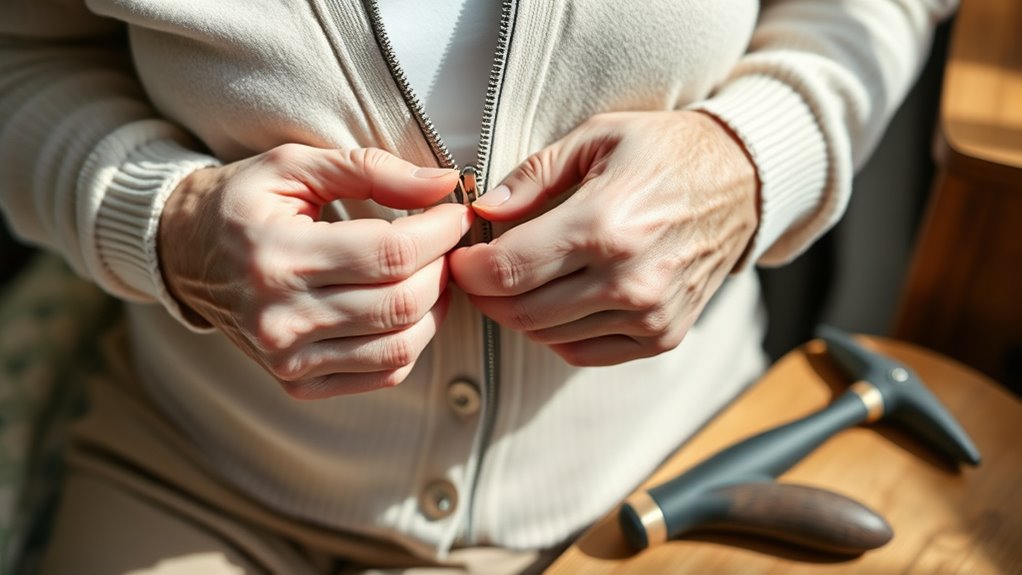Adaptive tools like zipper pulls, button hooks, and elastic shoelaces can make dressing easier with arthritis by reducing strain and simplifying fastenings. Sock aids, dressing sticks, and reachers help you avoid bending or stretching too much, promoting independence and safety. Seamless clothing options and adaptive fasteners keep dressing smooth and comfortable. Want to discover more ways to make dressing less stressful? Keep exploring for helpful tips and innovative solutions.
Key Takeaways
- Dressing aids like sock helpers, dressing sticks, and reachers reduce bending and strain during dressing routines.
- Easy-to-use fasteners such as Velcro, magnetic closures, and hidden zippers facilitate independent dressing.
- Adaptive tools like zipper pulls, button hooks, and elastic shoelaces simplify fastening and footwear management.
- Ergonomic, lightweight, and textured grips enhance safety, control, and comfort for users with limited hand mobility.
- Personalized clothing solutions and innovative assistive devices promote greater independence and ease of dressing.
Easy-to-Use Zipper Pulls and Tabs

For many people, manipulating small zipper pulls can be frustrating or even impossible. Arthritis weakens your grip and makes fine motor tasks more difficult. That’s where easy-to-use zipper pulls and tabs come in. These tools attach directly to your existing zippers, providing a larger, textured surface to grasp. You don’t have to pinch or squeeze as tightly, reducing strain on your fingers and hands. Some pulls feature ergonomic shapes or rubberized grips, which improve your control and comfort. With these simple adaptations, you can zip up jackets, bags, or pants with less effort. They’re lightweight, easy to install, and compatible with most standard zippers. These tools restore independence, making daily dressing tasks smoother and less painful. Using ergonomic designs can further enhance comfort and reduce fatigue during daily tasks. Additionally, selecting self-watering plant pots with ergonomic features can make gardening more accessible for individuals with arthritis, reducing the need for repetitive gripping or bending. Incorporating adaptive tools like these can also inspire creative ways to adapt other household items for easier use.
Button Hooks and Loops for Simplified Fastening
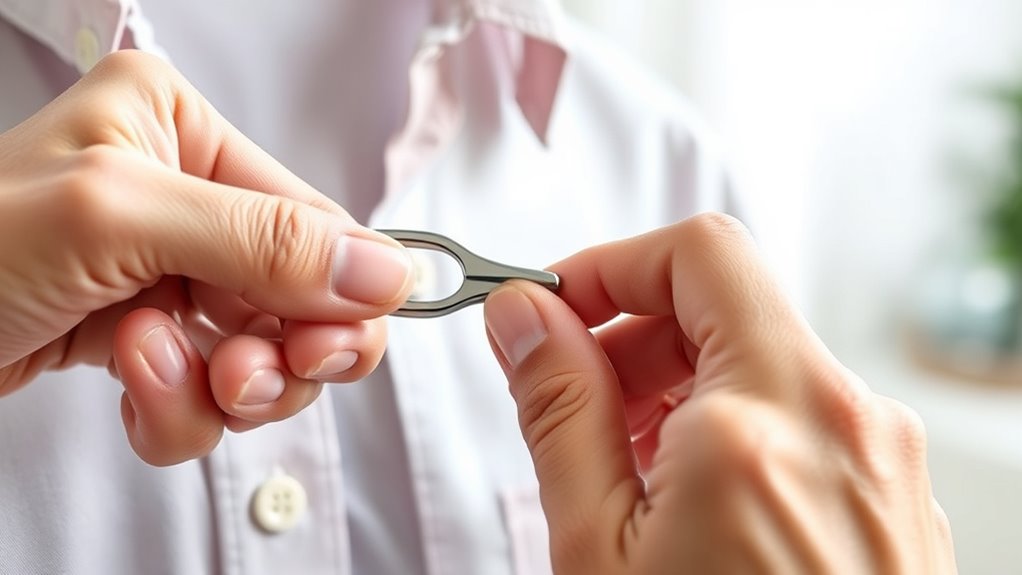
Button hooks and loops make fastening clothing much easier for those with limited dexterity or strength. They’re designed to help you manage buttons without struggling or putting too much pressure on your fingers. A button hook typically has a curved or hooked end, allowing you to easily catch and pull buttons through buttonholes. Loops, on the other hand, are simple elastic or fabric loops that you slip over buttons or button shanks. These tools save time and reduce frustration when dressing. They’re especially helpful for buttons on shirts, pants, or coats that are hard to reach or fasten. Using a button hook or loop can make dressing less tiring and more independent, giving you greater confidence and comfort throughout your day. Additionally, using adaptive clothing tools can further enhance ease of dressing and promote greater autonomy. Incorporating ergonomic designs in these tools can also improve grip and usability for people with arthritis. Designing such tools with user-friendly features can significantly improve their effectiveness and comfort. Embracing these tools aligns with the concept that creativity can be applied to develop practical solutions for everyday challenges. Moreover, selecting lightweight and durable materials can increase the usability and longevity of these adaptive aids.
Elastic Shoelaces and No-Tie Solutions
Have you ever struggled to tie your shoelaces, especially when in a hurry or dealing with limited dexterity? Elastic shoelaces and no-tie solutions make dressing easier by eliminating the need to tie and untie constantly. With elastic laces, you can simply slip your shoes on and off, adjusting the fit once, then enjoying a secure, comfortable hold. No-tie options like lock laces use a toggle mechanism to keep shoes snug without fuss. These tools save time, reduce frustration, and prevent accidents caused by loose laces. They’re especially helpful if you have arthritis or limited hand strength. Switching to elastic or no-tie laces can make your daily routine smoother, giving you more independence and confidence when dressing. The use of adaptive tools can also enhance overall security of your footwear, preventing accidental slips. User privacy policies ensure that your data and preferences are respected while using these adaptive tools.

Adapted Clothing and Seamless Designs
Adaptive clothing often features easy-to-use fasteners that make dressing simpler. Stretchable fabrics create seamless designs that move comfortably with you. Hidden closures keep your outfit sleek while maintaining practicality and style. Incorporating secure closure mechanisms can further enhance safety and ease of use. Additionally, digital platforms for design ideas can help manufacturers develop innovative adaptive clothing options that meet diverse needs. Exploring low light office plants can inspire designers to incorporate natural elements into clothing designs, promoting comfort and well-being. Using AI-driven personalization can also tailor clothing options to individual preferences and needs, ensuring greater comfort.
Easy-to-Use Fasteners
Because traditional fasteners can be challenging for some individuals to manipulate, designers have created easy-to-use alternatives that make dressing simpler. Velcro closures replace buttons and zippers, allowing you to secure clothing with a quick pull. Magnetic fasteners offer a similar benefit, snapping into place effortlessly and reducing finger strain. Hook-and-loop systems are adjustable and can be operated with minimal grip strength. Some garments feature elastic or slip-on designs that eliminate the need for fasteners altogether. These options help you dress independently, save time, and avoid frustration. By choosing clothing with easy-to-use fasteners, you support your mobility and comfort, making daily dressing more manageable and less stressful.
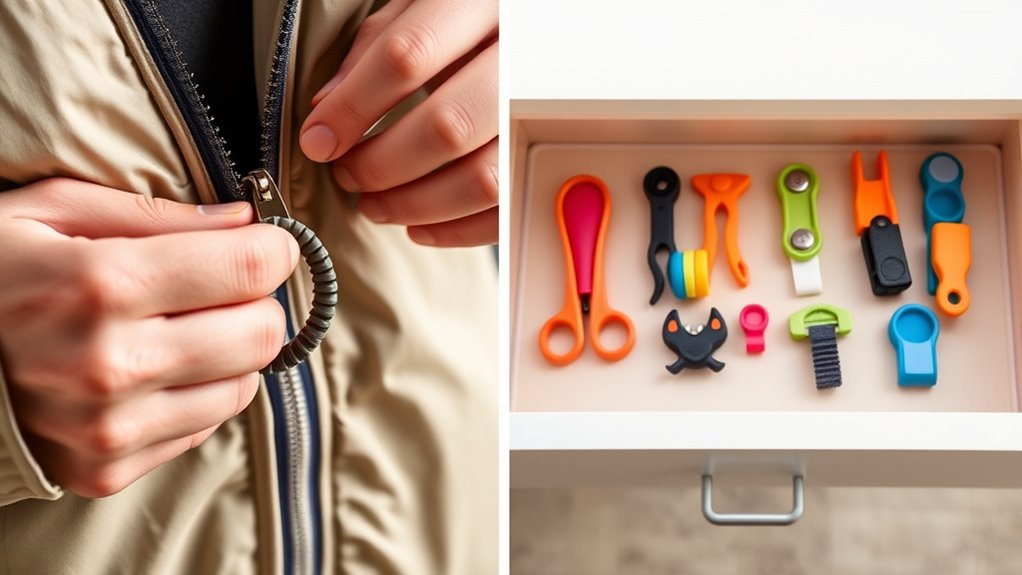
Stretchable Fabric Options
Stretchable fabrics are designed to move with your body, making dressing easier and more comfortable. These fabrics stretch and recover, accommodating limited joint mobility and reducing strain. When clothing incorporates stretchable materials, you can slip into garments with less effort and fewer frustrations. Seamless designs made from these fabrics eliminate uncomfortable seams that can irritate sensitive skin or cause pressure points. This flexibility allows for a better fit, especially as your body moves throughout the day. Plus, stretchable fabrics often hold their shape longer, maintaining a neat appearance with less frequent adjustments. Whether you’re choosing tops, pants, or adaptive underwear, opting for stretchable fabric options can notably improve your dressing experience and overall comfort.
Hidden Closure Designs
Hidden closure designs offer a seamless way to put on and take off clothing without the hassle of visible fasteners or difficult-to-manage zippers. These innovative features create a smooth silhouette and make dressing easier for arthritis sufferers. You won’t have to struggle with buttons or bulky closures, making dressing faster and less frustrating. Many garments incorporate hidden zippers, magnetic closures, or elastic panels that blend seamlessly into the fabric. This discreet approach preserves style while enhancing functionality.
- Invisible zippers that blend into seams
- Magnetic closures for quick fastening
- Elastic panels that stretch for easy wear
- Seamless designs eliminating bulky seams
Sock Aids and Assistive Devices for Footwear
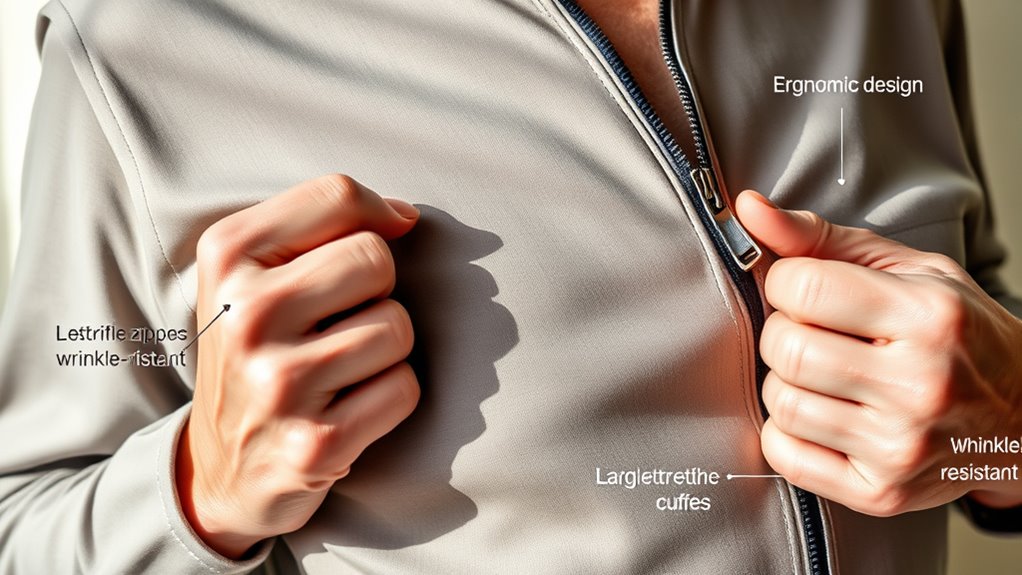
Sock aids and assistive devices make putting on footwear easier and safer, especially if you have limited mobility. They come in different designs to suit your comfort and needs, so choosing the right one matters. Let’s explore how to select the best aid for your situation. Incorporating ergonomic design principles can further enhance comfort and usability for users with arthritis. Using tools designed with universal accessibility ensures that individuals with various levels of mobility can benefit from easier dressing options. Additionally, selecting products made from diverse materials can improve durability and comfort for different users. Considering adaptive tools that support various physical limitations can also make dressing more manageable and reduce strain.
Ease of Use and Safety
For individuals with limited mobility or reduced flexibility, using dressing aids like sock aids and footwear assistive devices can considerably improve safety and independence. These tools are designed to be simple to operate, reducing the risk of falls or injury. They often feature non-slip grips and secure handles, making them easier to use confidently. Many devices are lightweight and portable, allowing you to use them anywhere. Properly designed aids help prevent strain and discomfort during dressing, supporting your safety.
Consider these key safety features:
- Non-slip grips for secure handling
- Ergonomic designs to reduce strain
- Lightweight materials for easy maneuverability
- Clear instructions for safe, effective use
Design Variations and Comfort
Design variations in dressing aids cater to different needs and preferences, making dressing easier and more comfortable. Sock aids come in several styles: some with flexible, stretchable sleeves, while others feature rigid frames for easier grip. Handles vary from simple loops to ergonomic designs that reduce hand strain. Comfort is also prioritized through padded grips and lightweight materials, reducing fatigue during use. Assistive devices for footwear range from long-handled shoehorns to slip-on adapters, allowing you to avoid bending or stretching. Some models include textured surfaces or non-slip features for better grip. These design differences help you find a tool that fits your specific mobility level, ensuring dressing remains a manageable, comfortable task despite arthritis challenges. The variety ensures you can select aids tailored to your comfort and ease.
Choosing the Right Aid
Choosing the right aid for dressing depends on your specific mobility needs and comfort preferences. To find the best fit, consider how easy it is to use, your level of flexibility, and the type of footwear you wear. Some aids work better for certain shoes or foot conditions. You might prefer a sock aid with adjustable height or a device that offers better grip. Keep in mind how much effort you’re willing to exert and whether the aid is portable for outings. Testing different options can help you determine what feels most comfortable and effective for your routine.
- Ease of use and grip
- Compatibility with your footwear
- Adjustability for comfort
- Portability for travel
Dressing Sticks and Reachers for Assistance
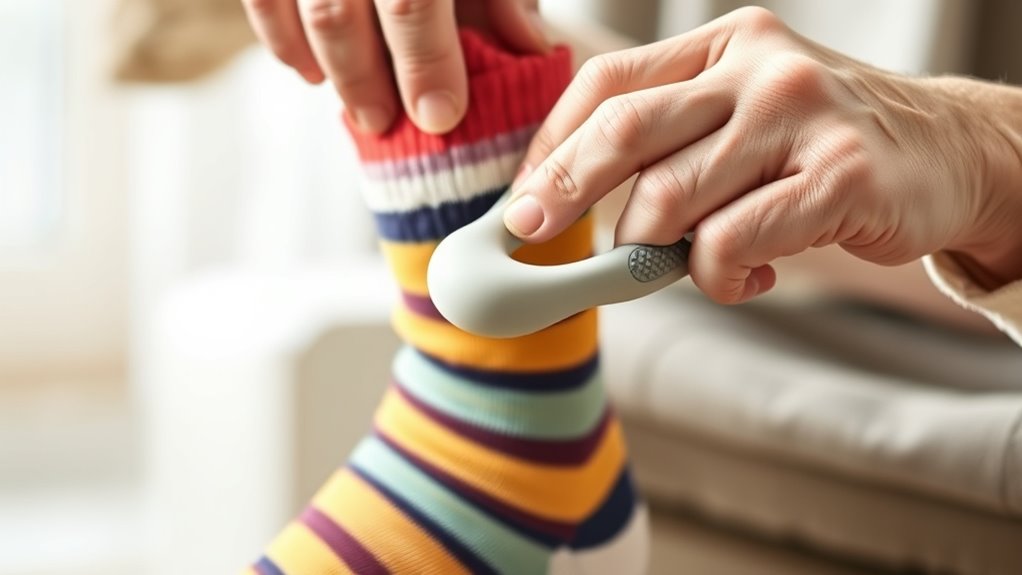
Dressing sticks and reachers are simple yet effective tools that help you put on clothes with less effort and strain. They extend your reach, making it easier to grab clothing, socks, or shoes without bending or twisting. With a dressing stick, you can pull up pants or skirts, while a reacher helps you pick up items from the floor or shelves. These tools are lightweight, easy to handle, and don’t require much strength, making dressing more manageable. Using a dressing stick or reacher can give you independence and confidence, helping you maintain daily routines with less pain and discomfort. Additionally, incorporating adaptive tools like these can improve overall comfort and safety during dressing.
Tips for Choosing the Right Adaptive Tools
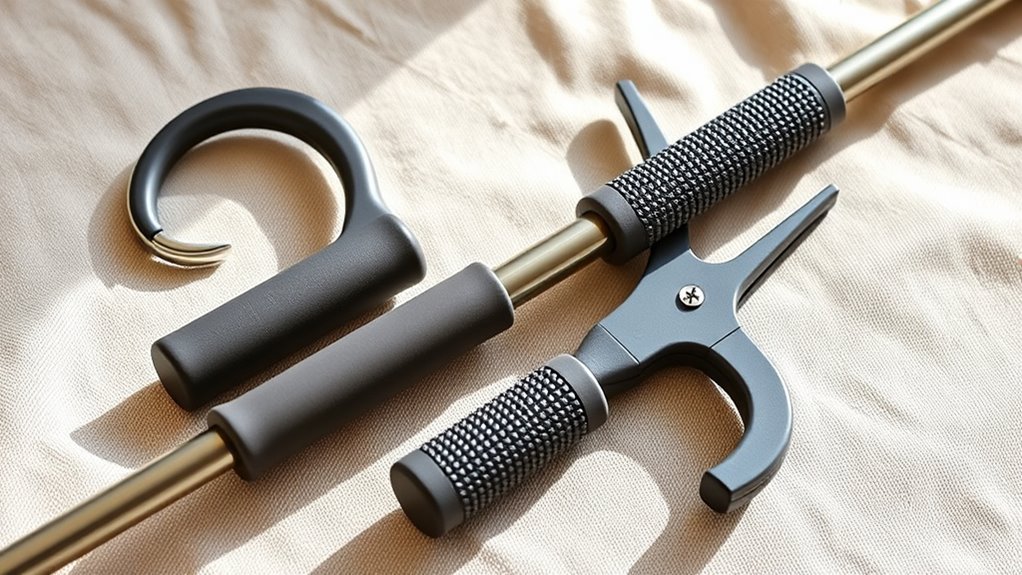
Selecting the right adaptive tools can considerably improve your dressing experience by making certain they fit your specific needs and abilities. When choosing tools, consider your hand strength, range of motion, and the types of clothing you wear most often. Look for ergonomic designs that reduce strain and are easy to grip. Think about the tool’s length and flexibility—longer tools can help reach difficult spots, while flexible options make maneuvering easier. Also, check if the tools are lightweight and comfortable to hold for extended periods.
- Prioritize tools with non-slip grips for better control
- Choose adjustable or multi-purpose tools for versatility
- Opt for lightweight, easy-to-handle designs
- Test tools in-store or read reviews to ensure they’re user-friendly
Frequently Asked Questions
Are Adaptive Dressing Tools Suitable for All Types of Arthritis?
You might wonder if adaptive dressing tools work for all arthritis types. While many tools, like zipper pulls and button aids, can help, their effectiveness depends on your specific condition and mobility. Some tools are better suited for less severe arthritis, while others assist more advanced cases. It’s best to try different options and consult with a healthcare professional to find the most suitable tools for your needs.
Can These Tools Be Used Independently Without Assistance?
Imagine your independence as a delicate dance—adaptive tools act as your trusted partners, guiding your steps. You can often use these tools solo, turning dressing into a smoother, more confident routine. They’re designed to support your movements, making tasks feel less like climbing a mountain. With the right tools, you hold the choreography, dancing through your day with ease, even when arthritis tries to lead you astray.
How Do I Clean and Maintain Adaptive Dressing Devices?
You want to know how to clean and maintain your adaptive dressing devices. First, check the manufacturer’s instructions for specific cleaning guidelines. Most devices can be wiped with a damp cloth and mild soap, then dried thoroughly. Avoid harsh chemicals or submerging electronic parts. Regular maintenance keeps your tools functioning properly and extends their lifespan, ensuring you can continue dressing independently and comfortably.
Are Adaptive Tools Customizable for Individual Needs?
Imagine a tailor customizing a suit to fit perfectly—that’s how adaptive tools work for you. Yes, many are customizable to suit your specific needs, whether you require larger handles or easier closures. You can often choose or modify features to make dressing less painful and more independent. This personalization guarantees the tools work seamlessly with your unique mobility and comfort requirements, making everyday dressing a more manageable task.
What Safety Precautions Should I Follow When Using Adaptive Dressing Aids?
When using adaptive dressing aids, you should prioritize safety to prevent injuries. Always check that tools are in good condition and free of damage before use. Keep your workspace clear to avoid tripping or falling. Use aids as instructed, and don’t force movements that cause pain. If you feel discomfort or instability, stop and seek advice. Regularly review your aids for proper fit and function to guarantee safe, effective dressing.
Conclusion
Think of adaptive dressing tools as your trusted compass on a challenging journey. They light the way, guiding you smoothly through each obstacle, so you can regain independence and confidence. With the right tools, you’re not just managing arthritis—you’re steering life’s path with resilience. Embrace these aids as your companions, turning daily struggles into opportunities for empowerment. Remember, even small steps with the right support lead to a brighter, more confident tomorrow.
